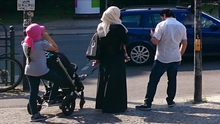Abaya

The Abaya or Abajeh ( Arabic عباية, DMG ʿabāya ; alsoعباءة Aba'a , DMG ʿabāʾa or Aba ) is a traditional Islamic garment. It is a type of overdress that women wear over normal clothing when they leave the house. In the Gulf region (especially in Yemen ) theabaya isoften combined with a headscarf, in poorer regions it is also combined with the face veil, the niqab . Depending on the social and religious environment, the abaya can vary from a very simple, baggy dress to a fashionable and sumptuous robe. But it always remains high-necked, long-sleeved and foot to floor length. The dominant color in the Arab world is black, in India and Pakistan other, often light colors are far more common.
Occasionally, the beech worn by men is also referred to as an " abaya ".
In a very few countries in the world, such as Yemen , wearing the abaya in public is a legal requirement. In March 2018, however, the Saudi Arabian Crown Prince Mohammed bin Salman announced that in future women would not be obliged to wear an abaya in public. The obligation to veil in Saudi Arabia should be dropped and women should be free to wear discreet and respectful clothing, although covering their hair is still a legal obligation for women. However, there has never been an official law on this, although a majority of the population assumed it was just as much as a driving ban for women.
See also
- Veil , there also specifically the section "Islam"
- Headscarf , there also specifically the section "Islam"
- Hijabista
- Pardösü
- Chador
- Jilbab
- Niqab
- Çarşaf
- Burqa
- Parda
- Burkini
- Shayla
- Headscarf dispute
- Ban on concealment
- World Hijab Day
